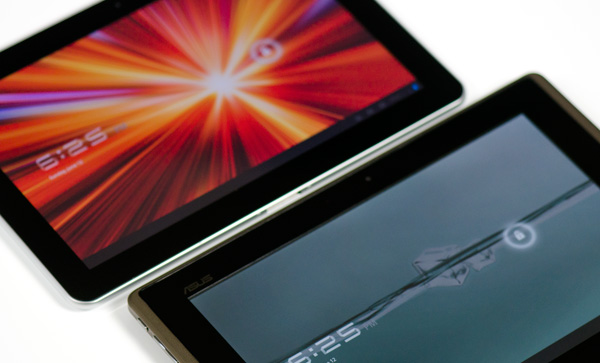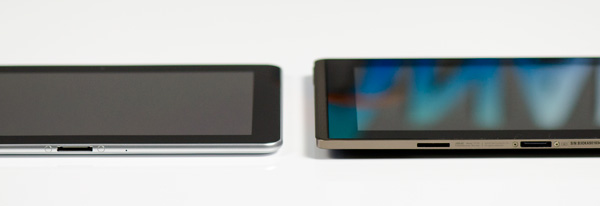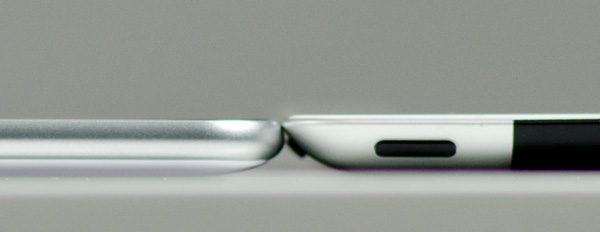Samsung Galaxy Tab 10.1 Review: The Sleekest Honeycomb Tablet
by Anand Lal Shimpi on June 13, 2011 5:07 AM EST- Posted in
- Tablets
- Samsung
- Tegra 2
- Galaxy tab 10.1
- Android 3.1
- Mobile
- NVIDIA
I remember standing in the audience of Samsung's CTIA press conference as it announced, for the first time ever, pricing and availability of its unreleased Galaxy Tab 10.1 and 8.9 before shipping. The smartphone (and early tablet) industries have gone this long without having to really compete based on price, mostly because in North America the carriers subsidize much of the cost. If every device costs $199 under contract, why get carried away with details like how much it actually costs?
The Galaxy Tab however was playing in a different space. While Apple ultimately caved to the pressures of carrier subsidies with the iPhone, the iPad remains completely unsubsidized and its followers buy it by the millions. The magical price point is $499 and it was at Samsung's CTIA press conference that it announced it would be matching Apple's $499 price point, and even dropping slightly below it for the 8.9-inch version.
At the time it seemed like a bold move, enough to give Honeycomb the fighting chance it needed. The Galaxy Tab would be thinner and lighter than the iPad 2 but competitively priced as well. This wouldn't be another Xoom.

Samsung Galaxy Tab 10.1 (top) vs. ASUS Eee Pad Transformer (bottom)
Then ASUS showed up. At $399, the Eee Pad Transformer not only offered a different usage model to the iPad and Galaxy Tab, it brought a lower price tag as well. Availability has been slim thanks to component shortages, but with the Eee Pad selling for $399 the Galaxy Tab at $499 all of the sudden seems overpriced.
| 2011 Tablet Comparison | ||||||
| Apple iPad 2 | ASUS Eee Pad Transformer | Motorola Xoom WiFi | Samsung Galaxy Tab 10.1 | |||
| SoC | Apple A5 (Dual ARM Cortex A9 @ 1GHz) | NVIDIA Tegra 2 (Dual ARM Cortex A9 @ 1GHz) | NVIDIA Tegra 2 (Dual ARM Cortex A9 @ 1GHz) | NVIDIA Tegra 2 (Dual ARM Cortex A9 @ 1GHz) | ||
| GPU | PowerVR SGX 543MP2 | NVIDIA GeForce | NVIDIA GeForce | NVIDIA GeForce | ||
| RAM | 512MB | 1GB | 1GB | 1GB | ||
| Display | 1024 x 768 IPS | 1280 x 800 IPS | 1280 x 800 | 1280 x 800 PLS | ||
| NAND | 16GB | 16GB | 32GB | 16GB | ||
| Dimensions | 241.2mm x 185.7mm x 8.8mm | 271mm x 175mm x 12.95mm | 249.1mm x 167.8mm x 12.9mm | 256.6 x 172.9 x 8.6mm | ||
| Weight | 601g | 695g | 730g | 565g | ||
| Price | $499 | $399 | $599 | $499 | ||
Based on specs alone you'd be right. Samsung's Galaxy Tab 10.1 has the same NVIDIA Tegra 2 tablet SoC inside,
1GB of LPDDR2 and 16GB of NAND on-board. You get a 10.1-inch 1280 x 800 PLS display and 802.11n WiFi support. It's worth pointing out that we're now well into the month of June and NVIDIA continues to be the only SoC vendor shipping in Honeycomb tablets. Samsung originally had plans to ship its own Exynos SoC in the Galaxy Tab but Tegra 2 remains the port of choice for all Honeycomb vendors at this point. Whether or not NVIDIA can win twice in a row with Ice Cream Sandwich later this year remains to be seen.

Samsung Galaxy Tab 10.1 (left) vs. ASUS Eee Pad Transformer (Right)
Where Samsung gives you something more for your money is in build quality and form factor. While Eee Pad Transformer feels surprisingly good for a cost reduced tablet, it doesn't feel nearly as slim or portable as the Galaxy Tab 10.1. It's no wonder Samsung went back to the drawing board on this one, the result is something that in many ways feels better than the iPad 2.
Apple still gets the nod in terms of quality of materials. The aluminum back of the iPad 2 is unbeatable. The Galaxy Tab 10.1 however feels lighter, a bit more rugged (I'm less concerned about scratching plastic than I am marring aluminum) and a little more comfortable to hold as a result. Against the Eee Pad there's no competition. I can live with the Eee Pad, but I much prefer the feel of the Galaxy Tab 10.1. The new Tab just feels like a device from this year - a compliment that, until now, I had only given to Apple.
The Galaxy Tab 10.1 measures just 8.6mm thick, 0.2mm thinner than the iPad 2. To be honest you really can't tell the difference, both devices feel thin. Ever after holding them back to back it's near impossible to tell that Samsung has built a thinner device. The most tangible difference in feel is the weight, not just in overall mass but in terms of weight distribution. The Galaxy Tab seems to carry the weight a bit better than the iPad, a bit more evenly.

Samsung Galaxy Tab 10.1 (left) vs. Apple iPad 2 (right)
Now is as good a time as any to point out that although Samsung calls this the Galaxy Tab 10.1, it's really the new Galaxy Tab 10.1. Originally Samsung announced a much thicker version at Mobile World Congress, a month prior to the CTIA announcement. With the much thinner iPad 2 hitting the market after the original 10.1 announcement, Samsung scrapped plans for the original and unveiled the thinner 8.6mm version as the new Galaxy Tab. The original Galaxy Tab 10.1 is now known as the Galaxy Tab 10.1v.












108 Comments
View All Comments
fteoath64 - Wednesday, June 15, 2011 - link
Very true. They had a chance to differentiate and blew it. MicroSD, Mini-HDMI and USBhost ports are really mandatory for any device because they additional modes for media consumption. Only Apple can get away with it, no one else.[insert name] - Sunday, June 19, 2011 - link
Hmmm.. the lack of both kinda killed the GT10 for me so I went looking at Xoom (too early, too flakey) the iconia (usual woeful levels of post-sales support) and the Transformer (ugly-looking, heavy and I read they too are having their problems, although I like the external HDD support on the dock!).So I went back to looking at the GT10; I can live without the HDMI port (my GT7 doesn't have it), but it's still the lack of uSD that's killing me - I have a 32GB uSD card chock-a-block full of music & videos and a 16GB one I use for business documentation, pressos etc.
Yes, I can just pay the ridiculous excess for the 32GB version, but it's a lot easier/faster to swap out a uSD card than plug 'n drag many, many GB of data...
Zandros - Monday, June 13, 2011 - link
"The Samsung supplied photo below shows a comparison of the tradeoff you make with S-IPS and I-IPS, as well as both of those compared to Super PLS"I'd say it's a near useless comparison, since there's no way you'll be looking at the three displays with the same horizontal angle at the same time.
RHurst - Thursday, June 16, 2011 - link
Exactly!MrSewerPickle - Monday, June 13, 2011 - link
Yet another excellent technical review. I read a lot of reviews online but typically wait for your opinion before making a decision. You make some excellent points as always about the impending Tegra 3 factor.Anyway I've been enjoying this site sense before Tom left Toms and it always continues to impress me. Keep up the unbiased technical reviews.
spambonk - Monday, June 13, 2011 - link
Does it have light bleed, like the Asus transformer and you didn't tell us.erple2 - Monday, June 13, 2011 - link
Page 6:<quote>On top of all of that, the LE suffered light bleed from one of its corners - a problem I haven't seen on the retail 10.1.</quote>
Sounds like the answer is "not on this unit".
erple2 - Monday, June 13, 2011 - link
Ratza fratza no edit button ratza fratza...Page 6:
Sounds like the answer is "not on this unit".
sammsiam - Monday, June 13, 2011 - link
The XOOM has 32GB of NANDAsteriskCGY - Monday, June 13, 2011 - link
Bought a Xoom on sale like 3 weeks ago 100 off retail. still had tax so ended up being 558 in the end. Glad its numbers are comparable but that weight really does factor in a lot. And if Kal El means I can start playing my 720 mkv's with subs instead of hunting for SD or 480 avi files for the stuff I watch might've been worth the wait.Or see who'd want to buy a xoom at that time.